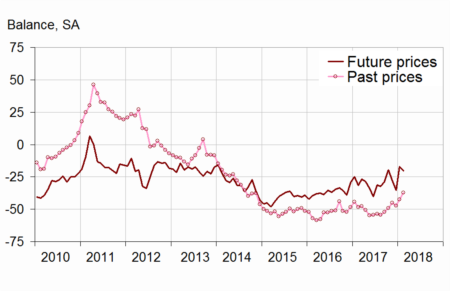 27 February 2018
2018- n° 52In February 2018, households' confidence is back to its long-term average (100) Monthly consumer confidence survey - February 2018
27 February 2018
2018- n° 52In February 2018, households' confidence is back to its long-term average (100) Monthly consumer confidence survey - February 2018
In February 2018, households' confidence in the economic situation declined sharply, after stabilizing in January: the synthetic index lost 4 points and is back to its long-term average (100).
In February 2018, households' confidence in the economic situation declined sharply, after stabilizing in January: the synthetic index lost 4 points and is back to its long-term average (100).
graphiqueGraph1 – Consumer confidence synthetic index

- Source: INSEE
Personal situation
Financial situation: sharp downturn
In February, household were more pessimistic than in January on their future financial situation: the corresponding balance lost 6 points and returned to its January 2015 level, far below its long-term average. Households' opinion on their past financial situation also worsened (−6 points). The corresponding balance fell slightly below its long-term average.
The proportion of households considering it is a suitable time to make major purchases was almost unchanged in February (−1 point). The corresponding balance stands clearly above its long-term average.
Savings intentions: slight decline
The share of households considering it is a suitable time to save decreased slightly in February (−2 points). The corresponding balance thus remains well below its long-term average.
In February, households' balance of opinion on their expected saving capacity dropped 5 points, while the one on their current saving capacity was virtually stable (−1 point). Both balances remain slightly above their long-term average.
graphiqueGraph2 – Balances on personal financial situation and standard of living in France

- Source: INSEE
tableauTable – CONSUMER OPINION: synthetic index and opinion balances
| Avg. (1) | Nov. 17 | Dec. 17 | Jan. 18 | Feb. 18 | |
|---|---|---|---|---|---|
| Synthetic index (2) | 100 | 102 | 104 | 104 | 100 |
| Financial sit., past 12 m. | –21 | –19 | –18 | –16 | –22 |
| Financial sit., next 12 m. | –5 | –11 | –11 | –13 | –19 |
| Current saving capacity | 8 | 12 | 11 | 12 | 11 |
| Expected saving capacity | –9 | –2 | –1 | –3 | –8 |
| Savings intentions, next 12 m. | 17 | 4 | 4 | 7 | 5 |
| Major purchases intentions, next 12 m. | –14 | –4 | –3 | –3 | –4 |
| Standard of living, past 12 m. | –45 | –39 | –33 | –33 | –37 |
| Standard of living, next 12 m. | –25 | –18 | –16 | –18 | –24 |
| Unemployment, next 12 m. | 34 | 6 | 8 | 4 | 4 |
| Consumer prices, past 12 m. | –17 | –45 | –47 | –42 | –37 |
| Consumer prices, next 12 m. | –34 | –28 | –35 | –17 | –20 |
- (1) Average value between January 1987 and December 2017
- (2) The indicator is normalised in such a way that its average equals 100 and standard error equals 10 over the estimation period (1987-2017).
- Source: INSEE, monthly consumer confidence survey
Economic situation in France
Future standard of living in France: less favourable assessment
In February, households were more pessimistic about the future standard of living in France: the corresponding balance lost 6 points and is back to its January 2017 level. Households also felt less favourably about the past standard of living in France: the corresponding balance declined by 4 points, after a two-month stability. However, both balances remain above their long-term average.
Unemployment: steady expectations
Households' opinion on unemployment trend was unchanged in February: the corresponding balance was stable and stays far below its long-term average.
graphiqueGraph3 – Households' unemployment expectations

- Source: INSEE
Perceived inflation: sharp rise
In February, households were more numerous than in January to consider that prices were on the rise during the last twelve months: the corresponding balance gained 5 points, reaching its highest level since August 2014. Nevertheless, it stands well below its long-term average.
However, households were slightly less numerous to expect prices to increase during the next twelve months: the corresponding balance lost 3 points after soaring in January (+18 points). It stands clearly above its long-terme average.
graphiqueGraph4 – Households' perception of prices

- Source: INSEE




